Top speed 925 km/h Cruise speed 710 km/h Wingspan 51 m | Range 15,000 km Length 46 m | |
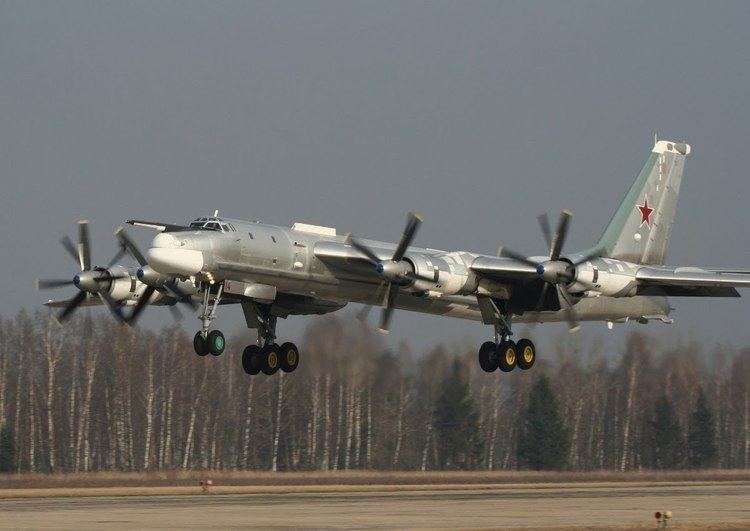 | ||
Unit cost 26,280,000–26,280,000 USD (2013) | ||
The Tupolev Tu-95 (Russian: Туполев Ту-95; NATO reporting name: "Bear") is a large, four-engine turboprop-powered strategic bomber and missile platform. First flown in 1952, the Tu-95 entered service with the Soviet Union in 1956 and is expected to serve the Russian Air Force until at least 2040. A development of the bomber for maritime patrol is designated Tu-142, while a passenger airliner derivative was called Tu-114.
Contents
- Design and development
- Tu 116
- Cold War symbol
- Present and future status
- Incidents
- Variants and derivatives
- Current
- Former
- Specifications Tu 95MS
- References
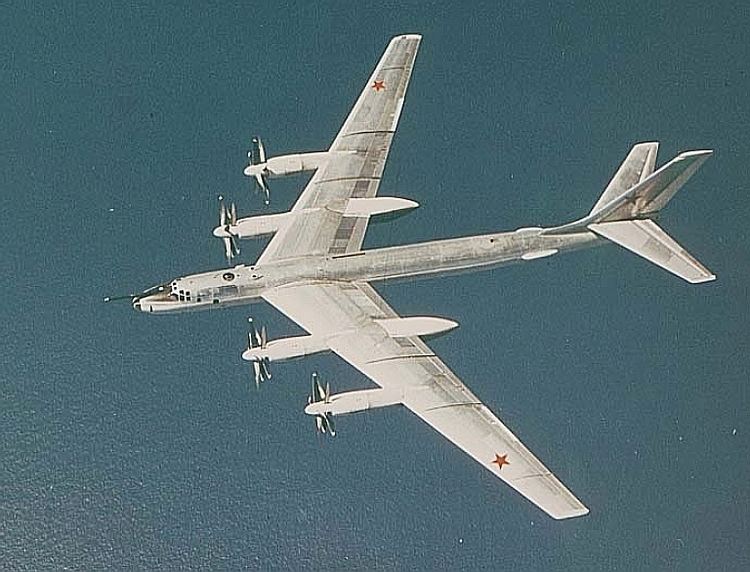
The aircraft has four Kuznetsov NK-12 engines with contra-rotating propellers. It is the only propeller-powered strategic bomber still in operational use today. The Tu-95 is one of the loudest military aircraft, purportedly because the tips of the propeller blades move faster than the speed of sound. Its distinctive swept-back wings are at a 35° angle. The Tu-95 is one of the very few mass-produced propeller driven aircraft with swept wings.
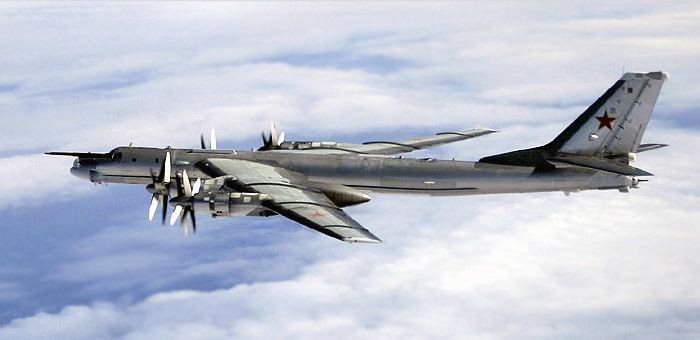
Design and development
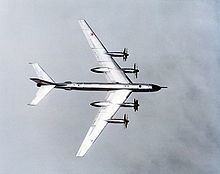
The design bureau led by Andrei Tupolev designed the Soviet Union's first intercontinental bomber, the 1949 Tu-85, a scaled-up version of the Tu-4, a Boeing B-29 Superfortress copy.
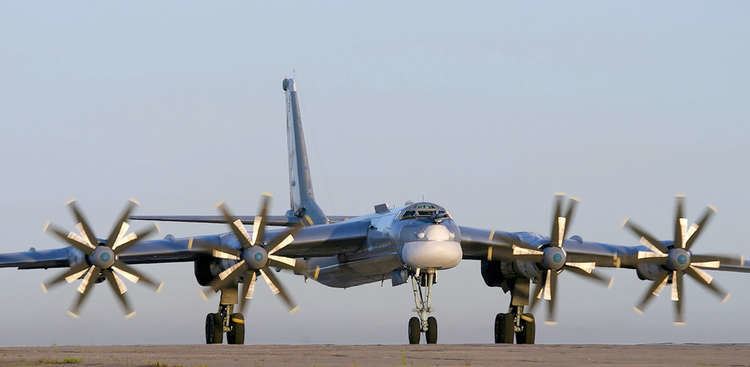
A new requirement was issued to both Tupolev and Myasishchev design bureaus in 1950: the proposed bomber had to have an un-refueled range of 8,000 km (4,970 mi)—far enough to threaten key targets in the United States. Other goals included the ability to carry an 11,000 kg load over the target.
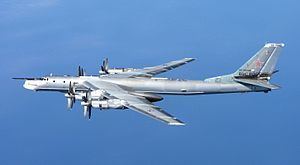
The big problem for Tupolev was the engine choice: the Tu-4 showed that piston engines were not powerful enough to fulfill that role, while the fuel-hungry AM-3 jet engines of the proposed T-4 intercontinental jet bomber did not provide adequate range. Turboprops offered more power than the piston engines and better range than jets available for the new bomber's development at the time, while offering a top speed in between these two alternative choices.
Tupolev's proposal was selected and Tu-95 development was officially approved by the government on 11 July 1951. It featured four Kuznetsov coupled turboprops, each fitted with two contra-rotating propellers of four blades each, producing a nominal 8,948 kW (12,000 eshp) power rating. The then-advanced engine was designed by a German team of ex-Junkers prisoner-engineers under Ferdinand Brandner. In contrast, the fuselage was conventional: a mid-wing cantilever monoplane with 35 degrees of sweep, an angle which ensured the main wing spar passed through the fuselage in front of the bomb bay. Retractable tricycle landing gear was fitted, with all three gear strut units retracting rearwards, with the main gear units retracting rearwards into extensions of the inner engine nacelles.
The Tu-95/I, with 2TV-2F engines, first flew in November 1952 with test pilot Alexey Perelet at the controls. After six months of test flights this aircraft suffered a propeller gearbox failure and crashed, killing Perelet. The second aircraft, Tu-95/II featured four of the 12,000 ehp Kuznetsov NK-12 turboprops which proved more reliable than the coupled 2TV-2F. After a successful flight testing phase, series production of the Tu-95 started in January 1956.
For a long time, the Tu-95 was known to U.S./NATO intelligence as the Tu-20. While this was the original Soviet Air Force designation for the aircraft, by the time it was being supplied to operational units it was already better known under the Tu-95 designation used internally by Tupolev, and the Tu-20 designation quickly fell out of use in the USSR. Since the Tu-20 designation was used on many documents acquired by U.S. intelligence agents, the name continued to be used outside the Soviet Union.
Initially the United States Department of Defense evaluated the Tu-95 as having a maximum speed of 644 km/h (400 mph) with a range of 12,500 km (7,800 mi). These numbers had to be revised upward numerous times.
Like its American counterpart, the Boeing B-52 Stratofortress, the Tu-95 has continued to operate in the Russian Air Force while several subsequent iterations of bomber design have come and gone. Part of the reason for this longevity was its suitability, like the B-52, for modification to different missions. Whereas the Tu-95 was originally intended to drop free-falling nuclear weapons, it was subsequently modified to perform a wide range of roles, such as the deployment of cruise missiles, maritime patrol (Tu-142), and even civilian airliner (Tu-114). An AWACS platform (Tu-126) was developed from the Tu-114. An icon of the Cold War, the Tu-95 has served not only as a weapons platform but as a symbol of Soviet and later Russian national prestige. Russia’s air force has received the first examples of a number of modernised strategic bombers Tu-95MSs following upgrade work. Enhancements have been confined to the bomber’s electronic weapons and targeting systems.
Tu-116
Designed as a stopgap in case the Tu-114A was not finished on time, two Tu-95 bombers were fitted with passenger compartments. Both aircraft had the same layout: office space, a passenger cabin consisting of 2 sections which could each accommodate 20 people in VIP seating, and the rest of the 70 m³ cabin configured as a normal airliner. Both aircraft were eventually used as crew ferries by the various Tu-95 squadrons. One of these machines is preserved at Ulyanovsk Central Airport.
Cold War symbol
The Tu-95RT variant in particular was a veritable icon of the Cold War as it performed a maritime surveillance and targeting mission for other aircraft, surface ships and submarines. It was identifiable by a large bulge under the fuselage, which reportedly housed a radar antenna that was used to search for and detect surface ships.
In a series of nuclear surface tests that were carried out by the Soviet Union in the early through mid 1960s, on October 30, 1961 a modified Tu-95 carried and dropped the AN602 device named Tsar Bomba, which was the most powerful thermonuclear device ever detonated. The bomb was attached outside underneath of the aircraft, and carrying the Tsar Bomba semi-externally, somewhat like a B.I Special version of the Avro Lancaster would with a Grand Slam eleven tonne "earthquake bomb", as the Tsar Bomba could not be carried internally inside a standard Tu-95's bomb-bay. Video footage of that particular test exists as it was filmed for documentation, and shows the specially adapted Tu-95V plane – painted with anti-flash white on its ventral surfaces — taking off carrying the bomb, in flight scenes of the interior and exterior of the plane and the detonation. Along with the Tsar Bomba, the Tu-95 proved to be a versatile bomber that would be the deliverer of the RDS-4 Tatyana, a fission bomb with a yield of forty-two kilotons, RDS-6S thermonuclear bomb, but the designs proved flawed, RDS-37, a 2.9-megaton thermonuclear bomb, and RP-30-32 200-kiloton bombs.
The early versions of this bomber lacked comfort for their crews. They had a dank and dingy interior and there was neither a toilet nor a galley in the aircraft. Though the living conditions on the bomber were unsatisfactory the crews would often take two 10-hour mission trips a week to ensure combat readiness. This gave an annual total of around 1,200 flight hours.
The bomber had the best crews available due to the nature of their mission. They would undertake frequent missions into the Arctic to practice transpolar strikes against the United States. Unlike their American counterparts they never flew their missions with armed nuclear weapons. This hindered their mission readiness due to the fact that live ammunition had to come from special bunkers on the bases and loaded into the aircraft from the servicing trench below the bomb bay, a process that could take two hours.
Present and future status
In 1992, newly independent Kazakhstan began returning the Tu-95 aircraft of the 79th Heavy Bomber Aviation Division at Dolon air base to the Russian Federation. The bombers joined those already at the Far Eastern Ukrainka air base.
All Tu-95s now in Russian service are the Tu-95MS variant, built in the 1980s and 1990s. On 18 August 2007, President Vladimir Putin announced that Tu-95 patrols would resume, 15 years after they had ended.
NATO fighters are often sent to intercept Tu-95s as they perform their missions along the periphery of NATO airspace, often in close proximity to each other.
Russian Tu-95s reportedly took part in a naval exercise off the coasts of France and Spain in January 2008, alongside Tu-22M3 Backfire strategic bombers and airborne early-warning aircraft.
During the Russian Stability 2008 military exercise in October 2008, Tu-95MS aircraft fired live air-launched cruise missiles for the first time since 1984. The long range of the Raduga Kh-55 cruise missile means Tu-95MS Bears can once again serve as a strategic weapons system.
On 17 November 2015, Tu-95s had their combat debut, being employed for the first time in long range airstrikes as part of the Russian military intervention in the Syrian Civil War.
Incidents
On June 8, 2015 a Tu-95 ran off a runway at the Ukrainka bomber base and caught fire during take-off in the far eastern Amur region. As a result, one crew member was killed.
On July 14, 2015 it was reported that a Tu-95MS had crashed outside Khabarovsk, killing two of seven crew members.
Variants and derivatives
Several other modification of the basic Tu-95/Tu-142 airframe have existed, but these were largely unrecognized by Western intelligence or else never reached operational status within the Soviet military.
Current
Russian Federation
Former
Union of Soviet Socialist Republics
Specifications (Tu-95MS)
Data from Combat Aircraft since 1945
General characteristics
Performance
Armament
